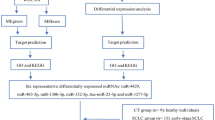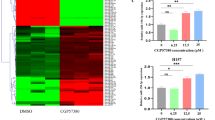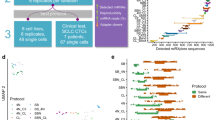Abstract
Small cell lung cancer (SCLC) constitutes approximately 15% of all diagnosed lung cancers. SCLC is a particularly lethal malignancy, as the 2-year survival rate after appropriate treatment is less than 5%. The patients with SCLC have not been received a benefit of the recently developed molecular targeted treatment. Therefore, a new treatment strategy is necessary for the patients. The molecular mechanisms underlying the aggressiveness of SCLC cells and their development of treatment-resistance are still ambiguous. In this study, we newly constructed a microRNA (miRNA) expression signature of SCLC by analysis of autopsy specimens. Based on the resultant signature, four miRNAs (miR-27a-5p, miR-485-3p, miR-34-5p and miR-574-3p) were found to be candidate anti-tumor miRNAs. To investigate their functional importance, we first validated the downregulation of miR-27a-5p and miR-34b-3p in SCLC clinical specimens. Next, we demonstrated that ectopic expression of both miR-27a-5p and miR-34b-3p significantly inhibited cancer cell aggressiveness. Our in silico analyses showed that four genes (topoisomerase 2 alpha (TOP2A), maternal embryonic leucine zipper kinase (MELK), centromere protein F (CENPF) and SRY-box 1 (SOX1) were identified as miR-27a-5p- and miR-34b-3p-regulated genes. Based on immunohistochemical analysis, TOP2A, MELK and CENPF were involved in SCLC pathogenesis. These genes might contribute to high proliferation and early metastatic spread of SCLC cells. Elucidation of differentially expressed miRNA-mediated cancer pathways based on SCLC signature may provide new insights into the mechanisms of SCLC pathogenesis.
Similar content being viewed by others
Log in or create a free account to read this content
Gain free access to this article, as well as selected content from this journal and more on nature.com
or
Accession codes
References
Chute, J. P., Chen, T., Feigal, E., Simon, R. & Johnson, B. E. Twenty years of phase III trials for patients with extensive-stage small-cell lung cancer: perceptible progress. J. Clin. Oncol. 17, 1794–1801 (1999).
Lassen, U., Osterlind, K., Hansen, M., Dombernowsky, P., Bergman, B. & Hansen, H. H. Long-term survival in small-cell lung cancer: posttreatment characteristics in patients surviving 5 to 18+ years—an analysis of 1714 consecutive patients. J. Clin. Oncol. 13, 1215–1220 (1995).
Amarasena, I. U., Walters, J. A., Wood-Baker, R. & Fong, K. Platinum versus non-platinum chemotherapy regimens for small cell lung cancer. Cochrane Database Syst. Rev. 8, CD006849 (2015).
Satouchi, M., Kotani, Y., Shibata, T., Ando, M., Nakagawa, K., Yamamoto, N. et al. Phase III study comparing amrubicin plus cisplatin with irinotecan plus cisplatin in the treatment of extensive-disease small-cell lung cancer: JCOG 0509. J. Clin. Oncol. 32, 1262–1268 (2014).
van Meerbeeck, J. P., Fennell, D. A. & De Ruysscher, D. K. Small-cell lung cancer. Lancet 378, 1741–1755 (2011).
Carthew, R. W. & Sontheimer, E. J. Origins and mechanisms of miRNAs and siRNAs. Cell 136, 642–655 (2009).
Bartel, D. P. MicroRNAs: genomics, biogenesis, mechanism, and function. Cell 116, 281–297 (2004).
Filipowicz, W., Bhattacharyya, S. N. & Sonenberg, N. Mechanisms of post-transcriptional regulation by microRNAs: are the answers in sight? Nat. Rev. Genet. 9, 102–114 (2008).
Friedman, R. C., Farh, K. K., Burge, C. B. & Bartel, D. P. Most mammalian mRNAs are conserved targets of microRNAs. Genome Res. 19, 92–105 (2009).
Nelson, K. M. & Weiss, G. J. MicroRNAs and cancer: past, present, and potential future. Mol Cancer Ther 7, 3655–3660 (2008).
Wiemer, E. A. The role of microRNAs in cancer: no small matter. Eur. J. Cancer. 43, 1529–1544 (2007).
Itesako, T., Seki, N., Yoshino, H., Chiyomaru, T., Yamasaki, T., Hidaka, H. et al. The microRNA expression signature of bladder cancer by deep sequencing: the functional significance of the miR-195/497 cluster. PLoS ONE 9, e84311 (2014).
Fukumoto, I., Kinoshita, T., Hanazawa, T., Kikkawa, N., Chiyomaru, T., Enokida, H. et al. Identification of tumour suppressive microRNA-451a in hypopharyngeal squamous cell carcinoma based on microRNA expression signature. Br. J. Cancer 111, 386–394 (2014).
Moriya, Y., Nohata, N., Kinoshita, T., Mutallip, M., Okamoto, T., Yoshida, S. et al. Tumor suppressive microRNA-133a regulates novel molecular networks in lung squamous cell carcinoma. J. Hum. Genet. 57, 38–45 (2012).
Goto, Y., Kojima, S., Nishikawa, R., Kurozumi, A., Kato, M., Enokida, H. et al. MicroRNA expression signature of castration-resistant prostate cancer: the microRNA-221/222 cluster functions as a tumour suppressor and disease progression marker. Br. J. Cancer 113, 1055–1065 (2015).
Goto, Y., Kurozumi, A., Nohata, N., Kojima, S., Matsushita, R., Yoshino, H. et al. The microRNA signature of patients with sunitinib failure: regulation of UHRF1 pathways by microRNA-101 in renal cell carcinoma. Oncotarget 7, 59070–59096 (2016).
Shepherd, F. A., Crowley, J., Van Houtte, P., Postmus, P. E., Carney, D., Chansky, K. et al. The International Association for the Study of Lung Cancer Lung Cancer Staging Project: proposals regarding the clinical staging of small cell lung cancer in the forthcoming (seventh) edition of the tumor, node, metastasis classification for lung cancer. J. Thorac. Oncol. 2, 1067–1077 (2007).
Mataki, H., Seki, N., Chiyomaru, T., Enokida, H., Goto, Y., Kumamoto, T. et al. Tumor-suppressive microRNA-206 as a dual inhibitor of MET and EGFR oncogenic signaling in lung squamous cell carcinoma. Int. J. Oncol. 46, 1039–1050 (2015).
Kamikawaji, K., Seki, N., Watanabe, M., Mataki, H., Kumamoto, T., Takagi, K. et al. Regulation of LOXL2 and SERPINH1 by antitumor microRNA-29a in lung cancer with idiopathic pulmonary fibrosis. J. Hum. Genet. 61, 985–993 (2016).
Mataki, H., Enokida, H., Chiyomaru, T., Mizuno, K., Matsushita, R., Goto, Y. et al. Downregulation of the microRNA-1/133a cluster enhances cancer cell migration and invasion in lung-squamous cell carcinoma via regulation of Coronin1C. J. Hum. Genet. 60, 53–61 (2015).
Zhou, L., Liang, X., Zhang, L., Yang, L., Nagao, N., Wu, H. et al. MiR-27a-3p functions as an oncogene in gastric cancer by targeting BTG2. Oncotarget 7, 51943–51954 (2016).
Wu, X., Bhayani, M. K., Dodge, C. T., Nicoloso, M. S., Chen, Y., Yan, X. et al. Coordinated targeting of the EGFR signaling axis by microRNA-27a*. Oncotarget 4, 1388–1398 (2013).
Acunzo, M., Romano, G., Palmieri, D., Lagana, A., Garofalo, M., Balatti, V. et al. Cross-talk between MET and EGFR in non-small cell lung cancer involves miR-27a and Sprouty2. Proc. Natl Acad. Sci. USA 110, 8573–8578 (2013).
Miao, Y., Li, J., Qiu, X., Li, Y., Wang, Z. & Luan, Y. miR-27a regulates the self renewal of the H446 small cell lung cancer cell line in vitro. Oncol. Rep. 29, 161–168 (2013).
Mataki, H., Seki, N., Mizuno, K., Nohata, N., Kamikawaji, K., Kumamoto, T. et al. Dual-strand tumor-suppressor microRNA-145 (miR-145-5p and miR-145-3p) coordinately targeted MTDH in lung squamous cell carcinoma. Oncotarget 7, 72084–72098 (2016).
Matsushita, R., Yoshino, H., Enokida, H., Goto, Y., Miyamoto, K., Yonemori, M. et al. Regulation of UHRF1 by dual-strand tumor-suppressor microRNA-145 (miR-145-5p and miR-145-3p): Inhibition of bladder cancer cell aggressiveness. Oncotarget 7, 28460–28487 (2016).
Yonemori, M., Seki, N., Yoshino, H., Matsushita, R., Miyamoto, K., Nakagawa, M. et al. Dual tumor-suppressors miR-139-5p and miR-139-3p targeting matrix metalloprotease 11 in bladder cancer. Cancer Sci. 107, 1233–1242 (2016).
Zhao, N., Sun, H., Sun, B., Zhu, D., Zhao, X., Wang, Y. et al. miR-27a-3p suppresses tumor metastasis and VM by down-regulating VE-cadherin expression and inhibiting EMT: an essential role for Twist-1 in HCC. Sci. Rep. 6, 23091 (2016).
Maugeri, M., Barbagallo, D., Barbagallo, C., Banelli, B., Di Mauro, S., Purrello, F. et al. Altered expression of miRNAs and methylation of their promoters are correlated in neuroblastoma. Oncotarget 7, 83330–83341 (2016).
Revathidevi, S., Manikandan, M., Rao, A. K., Vinothkumar, V., Arunkumar, G., Rajkumar, K. S. et al. Analysis of APOBEC3A/3B germline deletion polymorphism in breast, cervical and oral cancers from South India and its impact on miRNA regulation. Tumour Biol. 37, 11983–11990 (2016).
Hermeking, H. The miR-34 family in cancer and apoptosis. Cell Death Differ. 17, 193–199 (2010).
Choi, S. & Ku, J. L. Resistance of colorectal cancer cells to radiation and 5-FU is associated with MELK expression. Biochem. Biophys. Res. Commun. 412, 207–213 (2011).
Lin, M. L., Park, J. H., Nishidate, T., Nakamura, Y. & Katagiri, T. Involvement of maternal embryonic leucine zipper kinase (MELK) in mammary carcinogenesis through interaction with Bcl-G, a pro-apoptotic member of the Bcl-2 family. Breast Cancer Res. 9, R17 (2007).
Ganguly, R., Mohyeldin, A., Thiel, J., Kornblum, H. I., Beullens, M. & Nakano, I. MELK-a conserved kinase: functions, signaling, cancer, and controversy. Clin. Transl. Med. 4, 11 (2015).
Ganguly, R., Hong, C. S., Smith, L. G., Kornblum, H. I. & Nakano, I. Maternal embryonic leucine zipper kinase: key kinase for stem cell phenotype in glioma and other cancers. Mol. Cancer Ther. 13, 1393–1398 (2014).
Inoue, H., Kato, T., Olugbile, S., Tamura, K., Chung, S., Miyamoto, T. et al. Effective growth-suppressive activity of maternal embryonic leucine-zipper kinase (MELK) inhibitor against small cell lung cancer. Oncotarget 7, 13621–13633 (2016).
Chen, T., Sun, Y., Ji, P., Kopetz, S. & Zhang, W. Topoisomerase IIalpha in chromosome instability and personalized cancer therapy. Oncogene 34, 4019–4031 (2015).
Ceppi, P., Longo, M., Volante, M., Novello, S., Cappia, S., Bacillo, E. et al. Excision repair cross complementing-1 and topoisomerase IIalpha gene expression in small-cell lung cancer patients treated with platinum and etoposide: a retrospective study. J. Thorac. Oncol. 3, 583–589 (2008).
Meng, H., Chen, R., Li, W., Xu, L. & Xu, L. Correlations of TOP2A gene aberrations and expression of topoisomerase IIalpha protein and TOP2A mRNA expression in primary breast cancer: a retrospective study of 86 cases using fluorescence in situ hybridization and immunohistochemistry. Pathol. Int. 62, 391–399 (2012).
Dingemans, A. M., Witlox, M. A., Stallaert, R. A., van der Valk, P., Postmus, P. E. & Giaccone, G. Expression of DNA topoisomerase IIalpha and topoisomerase IIbeta genes predicts survival and response to chemotherapy in patients with small cell lung cancer. Clin. Cancer Res. 5, 2048–2058 (1999).
Huang, H., Liu, J., Meng, Q. & Niu, G. Multidrug resistance protein and topoisomerase 2 alpha expression in non-small cell lung cancer are related with brain metastasis postoperatively. Int. J. Clin. Exp. Pathol. 8, 11537–11542 (2015).
Nishikawa, R., Goto, Y., Kurozumi, A., Matsushita, R., Enokida, H., Kojima, S. et al. MicroRNA-205 inhibits cancer cell migration and invasion via modulation of centromere protein F regulating pathways in prostate cancer. Int. J. Urol. 22, 867–877 (2015).
O'Brien, S. L., Fagan, A., Fox, E. J., Millikan, R. C., Culhane, A. C., Brennan, D. J. et al. CENP-F expression is associated with poor prognosis and chromosomal instability in patients with primary breast cancer. Int. J. Cancer 120, 1434–1443 (2007).
Acknowledgements
The present study was supported by KAKENHI(C) grant 15K10801 and 16K19458.
Author information
Authors and Affiliations
Corresponding author
Ethics declarations
Competing interests
The authors declare no conflict of interest.
Additional information
Supplementary Information accompanies the paper on Journal of Human Genetics website
Supplementary information
Rights and permissions
About this article
Cite this article
Mizuno, K., Mataki, H., Arai, T. et al. The microRNA expression signature of small cell lung cancer: tumor suppressors of miR-27a-5p and miR-34b-3p and their targeted oncogenes. J Hum Genet 62, 671–678 (2017). https://doi.org/10.1038/jhg.2017.27
Received:
Revised:
Accepted:
Published:
Issue date:
DOI: https://doi.org/10.1038/jhg.2017.27
This article is cited by
-
Recent advances on high-efficiency of microRNAs in different types of lung cancer: a comprehensive review
Cancer Cell International (2023)
-
MicroRNA in lung cancer—a novel potential way for early diagnosis and therapy
Journal of Applied Genetics (2023)
-
Circulating miR-148b-3p and miR-27a-3p can be potential biomarkers for diagnosis of pre-diabetes and type 2 diabetes: integrating experimental and in-silico approaches
BMC Endocrine Disorders (2022)
-
KLF5-induced BBOX1-AS1 contributes to cell malignant phenotypes in non-small cell lung cancer via sponging miR-27a-5p to up-regulate MELK and activate FAK signaling pathway
Journal of Experimental & Clinical Cancer Research (2021)
-
Piperlongumine inhibits the growth of non-small cell lung cancer cells via the miR-34b-3p/TGFBR1 pathway
BMC Complementary Medicine and Therapies (2021)



